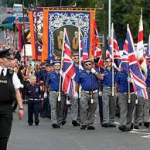A number of excellent publications have been produced in recent years as interest in The Great War continues to grow, particularly as we are in sight of various associated centenaries However, drama has an equally (if not more) important role in telling stories of the past whatever they may be. Drama has an amazing ability to inject raw ‘reality’ into a story, it can bring a tear to one’s eye and put a smile on one’s face, and in many ways this is more powerful than a history book, it brings the history book to life in ways that nothing else can. With this in mind I wish to place on record my delight that this play has come to fruition, I commend all those who have been involved from its inception to its execution before us in this theatre today.
For someone to have grown up recently in a unionist/loyalist community it would not be surprising if they were aware of the story of the‘gallant’ 36th (Ulster) Division at the Somme, a story involving heroic loyalty to king and country by volunteering for war and ultimately resulting in slaughter on the battlefields of France. For other people, the same story will have had more depth, perhaps set in the context of the Home Rule crisis, the formation of the Ulster Volunteer Force, their ‘inevitable transformation’ into the Ulster Division, but crucially, the same outcome, slaughter on the battlefields of France. Commemoration within the unionist community has a tendency to focus on the sacrifice of the Ulster Division, usually to the exclusion of other regiments who served in The Great War. It’s time for a wider approach in terms of commemoration and I hope to display this stance in a book I’m currently writing; East Belfast and The Great War. We are equally as indebted to those soldiers who were not Ulster Volunteers or indeed did not serve with the Ulster Division as those men who did. Not all U.V.F. men enlisted in the 36th(Ulster) Division, of the 100,000 strong U.V.F. there were only 17,000 men in the Ulster Division. David Fitzpatrick has claimed that only 48.7% of the Protestant enlistment figure had served with the U.V.F. before the outbreak of war.
The Ballymacarrett area of East Belfast had a population of which four-fifths were working class, usually employed in the shipyards and engineering workshops. The other one-fifth was made up of shopkeepers, professional men and clerks. Ireland may have been in some ways grateful when The Great War broke out in August 1914, given that the north appeared to be on a slippery slope towards civil war. Pressure had built up steadily throughout the course of the third Home Rule crisis, this left tensions high and the chance of suitable compromise low, it seemed the war had diverted all attention away from the Home Rule power struggle.
August 4 1914 to February 1915 was the peak period for voluntary enlistment, after this the recruitment slowed down slightly which may explain the initial recruitment ‘rush’ in Belfast. According to Cyril Falls; ‘when the recruiting officers arrived, the men came forward with a rush, above all in Belfast.’ The men of East Belfast were equally as enthusiastic. A young Tommy Ervine marched along Templemore Avenue from Orangefield with his companions to enlist in the 8th Battalion Royal Irish Rifles. One line of thought is that those in stable employment such as shipbuilding would have been less likely to swap their relatively healthy situations for trench warfare, however Professor Keith Jeffery and David Fitzpatrick have proved how shipyard and industrial workers were the most likely to enlist. Well-organised workforces such as Harland and Wolff would have created an element of peer pressure in order to join up. Men with jobs outside of shipbuilding had responsibilities to their families, and the separation payments by the War Office would not have compensated for their full-time wages. As men enlisted for the forces, they left their jobs behind, and these jobs became an opportunity and invariably a pull factor for some men to stay at home and benefit.
There were of course other factors which motivated men to volunteer for service. Political convictions no doubt played a huge part for many men, those who were involved with the U.V.F. will have been politically motivated to some extent. It is important to note that most of the recruits were young, and youthful exuberance is sometimes an underestimated factor, after all, the war would supposedly be over by Christmas 1914 and a few months in a foreign country was seen as an adventure. Joining as a group of friends or with family made the decision much easier for some individuals, and for this reason it’s easy to see how a clan spirit could be transferred from the Shipyard to the Somme.
A closer look at the Willowfield war memorial on the Woodstock Road shows that a majority did not join the 8th Battalion RIR, or even the 36th (Ulster) Division for that matter. This pattern is true for the whole of East Belfast, most of the men from the district did not join battalions of the Ulster Division. One explanation for this is that some of the men preferred to join units that were already stationed in Ulster as this was their closest point of contact with the British Army. Others deliberately chose specific regiments for specific reasons, for example financial benefits. During the delay in setting up the Ulster Division many eager souls would have joined regular units of the army, including as we have seen, Scottish and Canadian regiments. When the Ulster Division was secured following negotiations it allowed others enlist in groups of friends and in familiar surroundings which they would have felt more comfortable in, including for example, men of the East Belfast U.V.F.
The Ulster Division’s official farewell parade was held in Belfast on May 8 1915 when 17,000 troops marched through Belfast amidst a lavish display of flags, mainly Union flags, but also French, Belgian and Russian. The 8th Battalion R.I.R. assembled at the Willowfield Unionist Hall at 09:00 following their march from Ballykinler the day before, and from Willowfield proceeded to Malone via the Ormeau and Botanic parks. During the main procession, the East Belfast contingent were led by Col. H.T. Lyle and Major P.T. Chute, and as the battalion led the 107th Infantry Brigade, they were therefore the first infantry brigade to appear at the City Hall and take the salute.
By October 3 1915 the 8th Battalion RIR had departed from Folkestone at midnight for Boulogne. The battalion were in trenches at Mailly Mallet for the first time on 11 October and by 15 October they had suffered their first casualty, 2nd Lt. Pettigrew who received a bullet wound to the cheek. By the time the Ulster Division had reached France, at least seven men from the Willowfield memorial had already died serving with other regiments.
The journey for some of the men took them from the construction of the shipyards to the destruction on the Somme. July 1 1916 was quietly announced as the day of the major attack, somewhat coincidentally, given that it was the anniversary of the Battle of the Boyne, an important date to the Orange brethren within the Ulster Division. At 07:30 the East Belfast Battalion marched from Thiepval Wood to Elgin Avenue, where they would advance into no man’s land, Tommy Ervine was amongst them. He was struck by shrapnel crossing no man’s land but still made it to the German lines. Ervine was later shot in the leg following a confrontation with a German soldier, he remembered; ‘I’d have liked to get in among them Germans with my bayonet because they mowed us down like pieces of wood…it was terrible…it was cruel.’ As they continued their advance across no man’s land, the East Belfast men encountered a group of German prisoners, this made them more enthusiastic than ever about the battle. Perhaps though, it led the men into a false sense of security. By 09:40 the German‘B’ line had been captured and further prisoners were taken. However, the battalion had lost its direction and they found themselves too far to the left of their intended position. This mistake was corrected in the next advance towards the German ‘C’ line. Further advances were made towards ‘D’ line at 11:00, and this is where many casualties were suffered as the battalion were being fired upon from at least two sides. it was necessary at 11:08 to retreat back to ‘C’ line. Matters took a turn for the worse as Thiepval Wood was lost to enemy hands. Heavy casualties occurred at ‘C’ line also and so within an hour the men had to retreat further to the ‘B’ line. By this stage the battalion were in disarray, compounded by the fact that there was a shortage of grenades, and the Germans were clearly beginning to regain control of the situation. Three bombing raids were sent towards 8th Battalion at 15:50, one of which was dealt with single handedly by L/Cpl T.J. Allen, who bombed them and forced a retreat, but died ten minutes after returning to his trench. Another bombing attack caused Lt.Col. Pelly to record in the battalion diary that ‘things were looking bad’. This was until Lieut. Sanderson led a group of eight or nine men in a charge across open territory at the enemy, and although he was killed, it was noted that ‘no more annoyance was caused.’ The situation was grim and so the whole battalion were withdrawn to ‘A’ line and then back to their original front line at 23:45. After 17 hours of fierce fighting during which heavy casualties were endured, the men of East Belfast had not gained even an inch of territory. On 2 July, nine officers and 120 8th Battalion men were ordered to take part in a mixed party with orders to regain ‘A’ line, which was accomplished without much hindrance.
|
OFFICERS
|
OTHER RANKS
|
|
|
KILLED
|
N/A
|
24
|
|
WOUNDED
|
13
|
197
|
|
WOUNDED (AT DUTY)
|
2
|
19
|
|
MISSING
|
2
|
176
|
|
MISSING (BELIVED WOUNDED)
|
1
|
8
|
|
MISSING (BELIEVED KILLED)
|
2
|
2
|
|
TOTAL
|
20
|
426
|
Table I: Casualty list, as recorded on 3 July 1916 in the War Diary of 8th Battalion R.I.R.
From 4 July the 8th Battalion were taken off the front line and were relieved by the 49th Division. Throughout the month of July, reservists filled the ranks of the dead soldiers, and men who had been wounded on the first two days of the month gradually returned to duty. All this was happening much to the ignorance of the families at home as news was slow to filter home.
When the war had finally concluded the men who returned to the streets of Belfast struggled to adapt to ordinary civillian lifestyles following up to four years of traumatic experiences on various battlefields. One story is particularly harrowing about a shell shocked man from East Belfast who was at home during the Belfast Blitz of 1941. He disappeared when the bombing started and was found the next morning trembling in a hole he had dug for himself in his allotment.
We owe it to ALL the volunteers who served in The Great War regardless of which regiment they were with. The ‘Shipyard to the Somme’ drama has a particular East Belfast flavour to it but the story can be equally and accurately applied to various parts of Ulster. The Ulster Division and the Battle of the Somme are an important part of the narrative of the war, but it is essential that we widen our approach to honour all who were prepared to sacrifice their life for freedom in various theatres of battle.
WE WILL REMEMBER THEM






